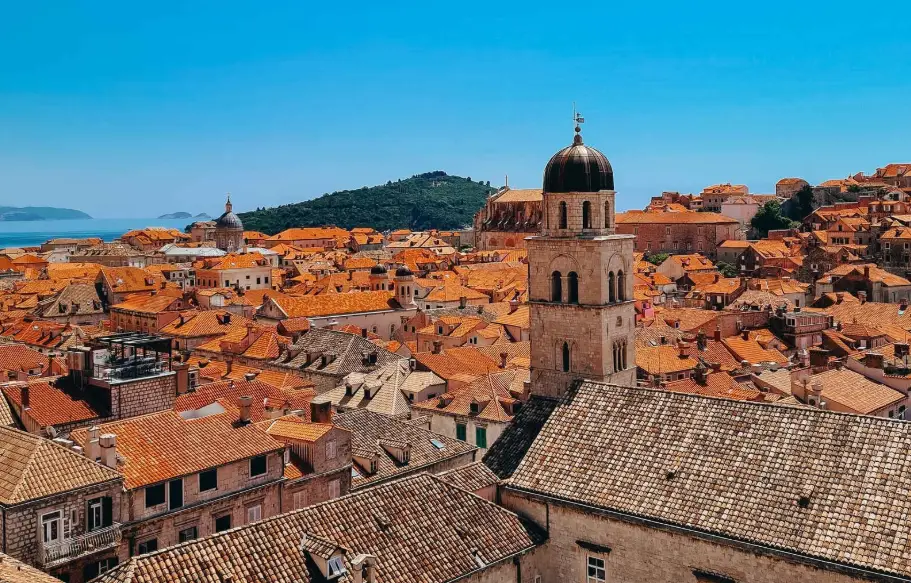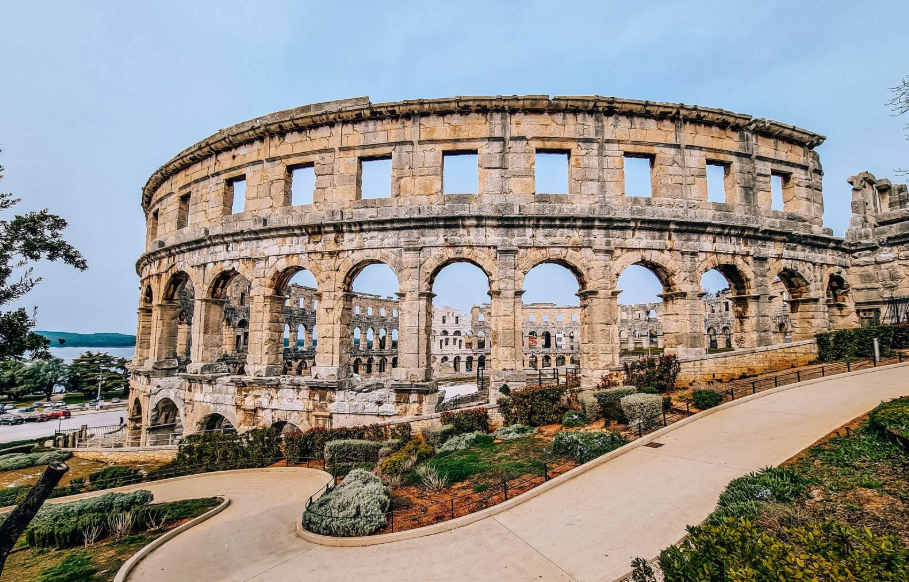Croatia is more than just stunning beaches on the Adriatic. It’s a country where ancient Roman ruins meet medieval towns, where waterfalls crash into turquoise lakes, and where modern art blends seamlessly with tradition.
If you’re planning a trip, here are the 15 most famous landmarks in Croatia you absolutely shouldn’t miss.
Table of Contents
Table of Contents
🏛️ Historical & Architectural Landmarks
1. Diocletian’s Palace (Split)
This UNESCO World Heritage Site was once the lavish retirement palace of Roman Emperor Diocletian. Today, it forms the very core of Split’s Old Town. You can wander through ancient marble colonnades, explore the underground cellars (famous for featuring in Game of Thrones), or sip coffee in the lively Peristyle Square.
✨ Why visit: It’s not just ruins—it’s a living city where history and modern life blend perfectly.
Best time to go: Evening, when warm lights glow across the stone alleys and live music fills the air.
2. Dubrovnik Old Town & City Walls (Dubrovnik)
Known as the “Pearl of the Adriatic,” Dubrovnik’s fortified old town is simply breathtaking. Walk along its 2 km-long medieval walls for panoramic views of terracotta rooftops against the deep blue sea. No wonder it became King’s Landing in Game of Thrones.
✨ Why visit: Watching the sunset from the city walls or the Lovrijenac Fortress is a bucket-list experience.
Best time to go: Spring or early autumn—milder weather and fewer crowds.
👉 Explore Dubrovnik Tours | 👉 Find Hotels in Dubrovnik
3. Pula Arena (Pula)
One of the world’s best-preserved Roman amphitheaters, the Pula Arena once hosted gladiator battles. Today, it’s still alive with summer concerts, opera performances, and the famous Pula Film Festival.
✨ Why visit: Imagine listening to live music under the stars in a 2,000-year-old arena.
Best time to go: July, during the film festival, for an unforgettable night.
4. St. Mark’s Church (Zagreb)
With its colorful tiled roof displaying medieval coats of arms, St. Mark’s Church is one of Zagreb’s most iconic sights. Located in the Upper Town, it’s surrounded by cobblestone streets and elegant Austro-Hungarian buildings.
✨ Why visit: On Sundays in summer, you can witness the ceremonial changing of the guard in full traditional costume.
Best time to go: Noon, when the square comes alive with tradition.
5. Trogir Old Town (Trogir)
A tiny island town and a UNESCO site, Trogir feels like stepping back in time. Its narrow stone alleys, Gothic churches, and Venetian palaces create a magical atmosphere.
✨ Why visit: The Cathedral of St. Lawrence features a stunning carved portal, and its bell tower offers panoramic sea views.
Best time to go: Evening, when the old town glows with lantern light and seaside restaurants come alive.
6. Šibenik Cathedral of St. James (Šibenik)
This Renaissance masterpiece is unlike any other cathedral—you won’t find a single wooden support inside. Instead, it’s entirely built from stone blocks, with 71 sculpted human faces decorating its façade.
✨ Why visit: A mix of artistry, architecture, and mystery, it’s also part of UNESCO’s World Heritage list.
Best time to go: Combine your visit with a day trip to nearby Krka National Park.
7. Trakošćan Castle (Varaždin County)
Perched on a forested hill above a serene lake, Trakošćan Castle looks like something from a fairy tale. Inside, you’ll discover historic paintings, antique furniture, and an atmospheric armory.
✨ Why visit: The surrounding forest is magical, especially in autumn when the leaves turn gold.
Best time to go: October, for the best scenery.
🌊 Natural Landmarks
8. Plitvice Lakes National Park
Perhaps Croatia’s most famous natural wonder, Plitvice features 16 shimmering lakes linked by countless waterfalls and wooden pathways. It’s one of those places where every angle feels like a postcard.
✨ Why visit: Crystal-clear waters, lush forests, and cascades that seem endless.
Best time to go: Spring (lush greenery) or autumn (fewer crowds, golden colors).
9. Krka National Park
Similar to Plitvice but less crowded, Krka offers equally stunning cascades. The highlight is Skradinski Buk, where visitors can swim in designated areas near the falls.
✨ Why visit: You can swim with waterfalls as your backdrop—something you can’t do in Plitvice.
Best time to go: Summer, for the perfect refreshing dip.
10. Blue Cave (Biševo Island)
A surreal natural wonder, the Blue Cave glows with an ethereal blue light as sunlight reflects through the sea floor. Accessible only by boat, it’s a magical experience.
✨ Why visit: It’s like stepping into another world—photographers love it.
Best time to go: Midday, when the glow is at its brightest.
11. Zlatni Rat Beach (Brač Island)
Known as the “Golden Horn,” this ever-changing V-shaped beach extends into the sea, shifting with tides and winds. It’s one of Europe’s most photographed beaches.
✨ Why visit: Perfect for windsurfing, paddleboarding, or simply relaxing with stunning views.
Best time to go: June–September for warm waters.
12. Paklenica National Park
A paradise for outdoor lovers, Paklenica offers dramatic canyons, rugged peaks, and over 400 climbing routes. It’s part of the Velebit mountain range and a UNESCO Biosphere Reserve.
✨ Why visit: Perfect for hiking, climbing, or escaping into raw Croatian nature.
Best time to go: Spring and autumn for cooler hiking weather.
🎭 Cultural & Unique Sites
13. Euphrasian Basilica (Poreč)
This 6th-century basilica is one of the finest examples of Byzantine art in Europe. Inside, glittering golden mosaics tell stories from early Christianity.
✨ Why visit: Its mosaics rival those of Ravenna in Italy but without the crowds.
Best time to go: Morning, when sunlight makes the mosaics sparkle.
14. Mljet National Park (Mljet Island)
This lush island is a paradise of saltwater lakes, pine forests, and a tiny monastery sitting on an islet in the middle of Veliko Jezero (Big Lake). According to legend, Odysseus was shipwrecked here.
✨ Why visit: Rent a kayak and paddle across the calm lakes—it feels otherworldly.
Best time to go: Summer, for swimming and kayaking.
15. The Sea Organ (Zadar)
A modern architectural masterpiece, the Sea Organ uses the waves of the Adriatic to create hauntingly beautiful sounds through underwater pipes. Nearby, the “Greeting to the Sun” installation lights up at night.
✨ Why visit: Sit on the marble steps, listen to the sea’s music, and watch one of Europe’s most famous sunsets.
Best time to go: Sunset—pure magic.
10 Days in Croatia: The Perfect Itinerary for First-Time Visitors

Here’s how to see all these landmarks in just 10 days:
- Day 1: Arrive in Zagreb → Explore Upper Town & St. Mark’s Church
- Day 2: Trakošćan Castle + Varaždin day trip
- Day 3: Plitvice Lakes National Park
- Day 4: Zadar → Sea Organ & Roman ruins
- Day 5: Šibenik + Krka National Park
- Day 6: Split → Diocletian’s Palace
- Day 7: Trogir Old Town
- Day 8: Island trip to Hvar or Brač (Zlatni Rat Beach)
- Day 9: Blue Cave & Vis Island excursion
- Day 10: Dubrovnik → Old Town & City Walls
Final Thoughts
Croatia is a land where history whispers through stone walls, waterfalls tumble endlessly, and the sea itself plays music. Whether you’re wandering through Diocletian’s Palace, swimming under Krka’s waterfalls, or watching the sun set over Zadar’s Sea Organ, each landmark tells a story that stays with you forever.
